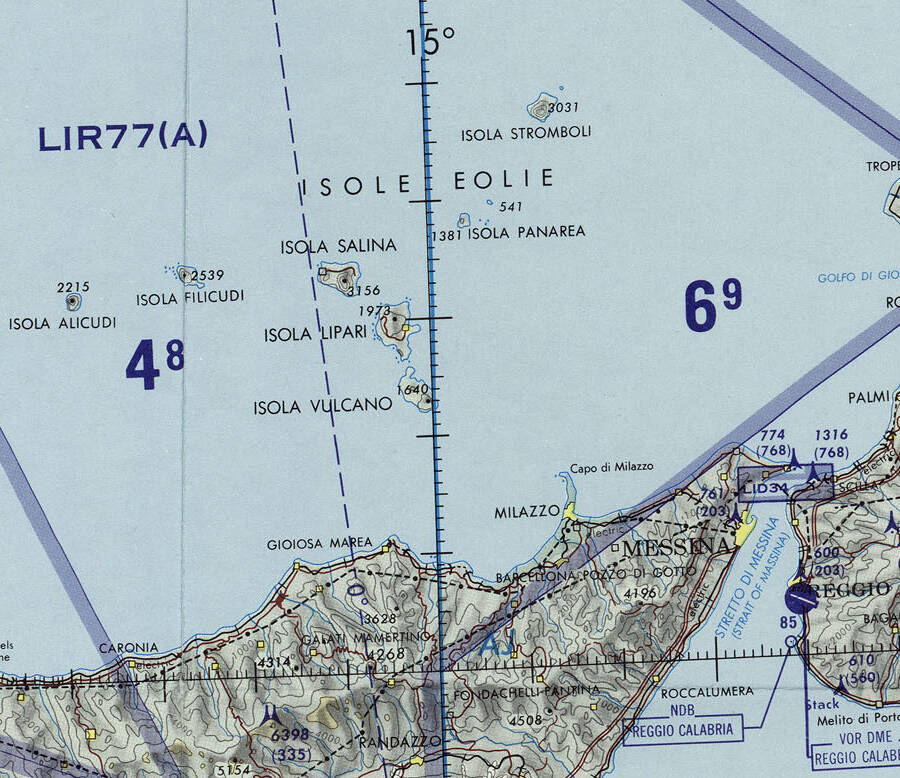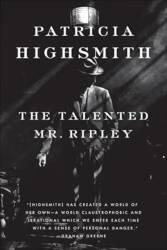
Stromboli
Arrival on Stromboli
I had spent a few days on Vulcano,
the Aeolian island closest to the coast of Sicily.
Now I would continue by ferry to Stromboli,
the northernmost inhabited island in that group.
The ferry would make brief stops at Lipari, Salina,
and Panarea before reaching Stromboli.

Portion of aeronautical chart ONC G-2 from the Perry-Castañeda Library Map Collection at the University of Texas at Austin.
The Aeolian islands rise out of the Tyrrhenian Basin, which is 2,400 meters or over 1,300 fathoms deep around Stromboli.
The Greeks observed that the island has the shape of a steep cone, giving it an approximately circular shoreline. They called the island Strongýlē, from the word στρογγύλος or strongýlos, meaning "round", from which we got Stromboli. This chart illustrates the steepness of its slopes by how close the 100 fathom line is to its shoreline.

Portion of aeronautical chart TPC G-2B from the Perry-Castañeda Library Map Collection at the University of Texas at Austin.
I had purchased my ticket the day before, at the hotel facing the ferry port.
When I had purchased a ferry ticket in Milazzo
for the trip to Vulcano,
it had seemed like an overly complicated process.
It was made worse by the ticket agent's computer not
working in some way.
She had entered everything into her phone,
including my name and passport number.
Well, more or less.
Rather than:
ROBERT CROMWELL
she had entered:
ROBERT CROWNE
Then, on Vulcano, rather than go through the data collection and data entry again, the agent there had asked if I had my first ticket. Well, yes, it was still in my shirt pocket. And so I continued my travels through the Tyrrhenian Sea under the assumed name of Robert Crowne. I felt a little like Tom Ripley.
The next day I packed my things, left my nice lodging on Vulcano, and got lunch at the port. Mid-afternoon, the M/V Alessandro Morace arrived. It had been raining off and on through the day so far.


Arriving on Stromboli
The rain and wind worsened as we made our way to Stromboli. The Alessandro Morace was rolling 15–20° to port and starboard while loosely tied alongside the pier at Stromboli, making disembarking a little tricky.
The pros were there, a vehicle belonging to Instituto Nazionale de Geofisica e Vulcanologia was parked near the ferry pier on Stromboli. That's the volcano in the background, partly hidden by clouds.

Stromboli had reached a population of approximately 2,700 people in the early 1890s. Italy's post-Risorgimento economy struggled, and there were eruptions and earthquakes. The downy mildew disease in the 1930s wiped out almost all of the grapevines. Most of the people left, especially for Australia and the U.S.A. The 2022 census counted 497 residents on Stromboli.
However, close to the ferry pier there were signs for the library and the film museum, not things you typically expect in a community this size.

My pictures do not capture the strength of the rain and wind. Meanwhile, Booking.com was sending me off on a wild goose chase looking for my lodging. I was having the Booking app guide me, and so it was sending me to precisely-specified coordinates in the middle of a garden 150 meters away from where I would be staying. No, what I needed to do was go to Google Maps or equivalent and enter the property's name and address.
Below are the typical vehicles on the primary road running from northwest to southeast through the town. This is the main road through town. Most of the lanes were narrower, some narrow enough and running between buildings and walls so that two people would have to negotiate passing each other. And, many of the narrow lanes had staircases. The small motor vehicles seen below could only take you to the approximate vicinity of many places.



Despite Booking's efforts, I found my accommodations. Above is the lane past where I was staying as seen well after my arrival, after the storm had passed. Below is the entrance to Pedra Residence on the morning of a following sunny day.

My room opened onto the porch one level above the level with the sign.

It was furnished with vintage cabinetry.


The typical large and small bed combination.

The room had a small kitchenette area.

It was not a dual turntable on which to throw down some phat beats, but a two-burner induction stove.

The terrace one level further up had great views, starting with the view up the 926-meter volcanic cone. It was still covered with clouds, the view improved as the storm moved away.

Looking out the other way, I could see Strombolicchio about 1.5 kilometers offshore.

Looking parallel to the shore, I could see the church at the main square.

I got dried off, and got settled into my room. Then I headed back out to explore the town.
Where Next In Italy?
( 🚧 = under construction )
In the late 1990s into the early 2000s I worked on a project to
scan cuneiform tablets
to archive and share 3-D data sets,
providing enhanced visualization to assist reading them.
Localized histogram equalization
to emphasize small-scale 3-D shapes in range maps, and so on.
I worked on the project with Gordon Young,
who was Purdue University's only professor
of archaeology.
Gordon was really smart,
he could read both Sumerian and Akkadian,
and at least some of other ancient languages
written in the cuneiform script.
He told me to go to Italy,
"The further south, the better."
Gordon was right.
Yes, you will very likely arrive in Rome,
but Italy has domestic flights and a fantastic train system
that runs overnight sleepers all the way to
Palermo and Siracusa, near the western and southern corners
of Sicily.
So, these pages are grouped into a south-first order,
as they should be.

